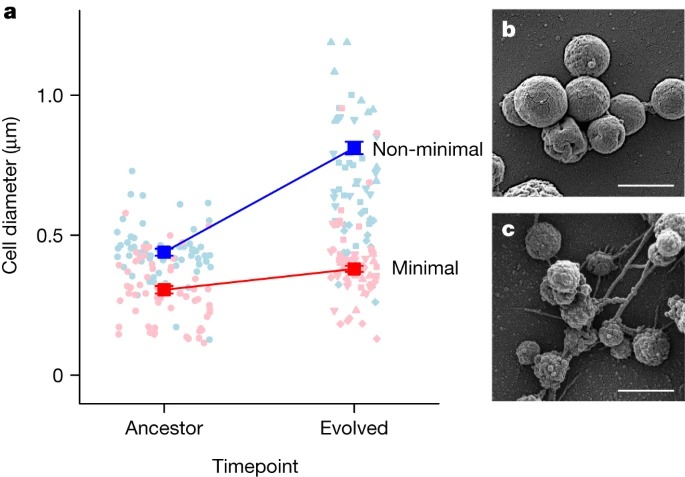minimal cell의 진화.

Abstract
essential genes만 보유한 minimal cell은 persistence and stability of life에 중요한 메커니즘과 과정을 밝혀낼 수 있습니다.
여기에서는 engineered 된 minimal cell이 synthetically derived된 Mycoplasma mycoides non-minimal cell와 비교하여 forces of evolution에 어떻게 대항하는지에 대해 보고합니다. 보고된 모든 bacteria 중 Mutation rates이 가장 높았지만 genome minimization의 영향을 받지 않았습니다. Genome streamlining는 비용이 많이 들어 fitness가 50% 이상 감소했지만, 2,000세대에 걸친 진화를 통해 이 deficit은 회복되었습니다. distinct genetic targets에 작용하는 선택에도 불구하고 synthetic cells의 maximum growth rate은 비슷하게 증가했습니다. 또한 relative fitness로 성능을 평가했을 때, minimal cell은 non-minimal cell보다 39% 더 빠르게 진화했습니다. The only apparent constraint는 cell size의 진화와 관련이 있었습니다. non-minimal cell의 크기는 80% 증가한 반면, minimal cell은 동일하게 유지되었습니다. 이 패턴은 cell division and morphology를 조절하는 tubulin-homologue protein을 encodes하는 ftsZ의 mutations의 epistatic effects를 반영합니다. 우리의 연구 결과는 natural selection이 가장 단순한 autonomously growing organisms 중 하나의 fitness를 빠르게 증가시킬 수 있음을 보여줍니다. small genomes을 가진 종이 evolutionary challenges을 극복하는 방법을 이해하면 host-associated endosymbionts의 persistence, stability of streamlined chassis for biotechnology 및 targeted refinement of synthetically engineered cells에 대한 중요한 통찰력을 얻을 수 있습니다.
